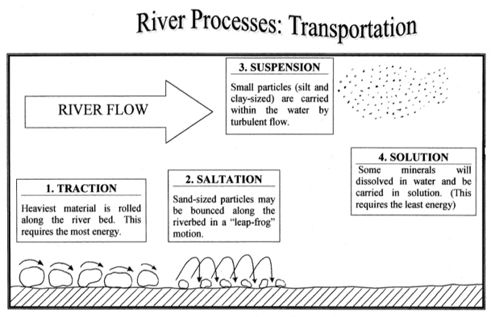This process has many steps. Precipitaion- condensed water vapor that falls to earth. Canopy interception- precipitation that is intercepted by plant foliage and evaporates back to the atmosphere. Snowmelt- Runoff produced by melting snow. Runoff- The way water moves across land. Infiltration- The flow of water into the ground. Subsurface flow- Flow of water underground. Evaporation- Transformation of water from liquid to gas. Sublimation- Change from solid water to water vapor. Advection- The movement of water through the atmosphere. Condensation- Transformation of water vapor to liquid water in the air. Transpiration- Release of water vapor from plants and soil into the air.
(1)
Rivers and Streams:
There are 3 main types of streams. Ephemeral-Streams regularly exist for short periods of time. Intermittent-streams flow at different times of the year when there is enough water. Perennial- streams that flow year-round. (2)
When humans build things it effects rivers and streams because building materals get dumped into the water, things may block the flow and pollutants get thrown in killing all life in and around the water. The highest threat levels are in the United States and Europe. Globally between 10,000 and 20,000 aquatic species are at risk because of how bad humans treat wetland. The worlds least affected rivers were the ones farthest away from populated areas. (4)
http://photos1.blogger.com/blogger2/3514/4365/1600/RiverTransport.jpg

"Here we focus on the local hydrologic cycle for a watershed. The important factors are precipitation, evapotranspiration, overland flow, infiltration, groundwater flow and stream flow, along with special manifestations of each referred to, respectively, as baseflow (groundwater flow into streams), runoff (different authors use different definitions) and subsea flow (deep groundwater flow directly into the adjacent ocean or estuaries). The following notation will be used to represent the associated watershed components:" (3)
| Components of Local Water Cycle P = Precipitation Qswi = Surface water in (e.g. stream flow into the watershed, and overland flow that enters directly) Gin = Groundwater flow in Qswo = Surface water out (e.g. stream flow, and overland flow that exits independently of streams) ET = Evapotranspiration Gout = Groundwater flow outDS/Dt = Change in the volume of water in storage (S) per unit time |
http://www.brown.edu/Courses/GE0158/web2_revised/dennis/basic.html
1. http://en.wikipedia.org/wiki/water_cycle, wikipedia, Nov. 21, 2011, Wikimedia Foundation inc
2. http://www.epa.gov/bioiweb1/aquatic/rivers_and_streams.html , U.S. Environmental Protection Agency, March 7, 2011
3. http://www.brown.edu/Courses/GE0158/web2_revised/dennis/basic.html ,THe hydrologic cycle, Dennis Wong, John F. Hermance
4. http://www.guardian.co.uk/environment/2010/sep/29/human-impact-world-rivers-water-security , Theguardian, 2011,
No comments:
Post a Comment